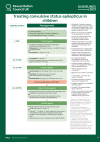Optimal Management of Status Epilepticus in Children in the Emergency Setting: A Review of Recent Advances
- PMID: 36158897
- PMCID: PMC9491331
- DOI: 10.2147/OAEM.S293258
Optimal Management of Status Epilepticus in Children in the Emergency Setting: A Review of Recent Advances
Abstract
Convulsive status epilepticus (CSE) is the most common neurological emergency in children and the second most common neurological emergency in adults. Mortality is low, but morbidity, including neuro-disability, learning difficulties, and a de-novo epilepsy, may be as high as 22%. The longer the duration of CSE, the more difficult it is to terminate, and the greater the risk of morbidity. Convulsive status epilepticus is usually managed using specific national or local algorithms. The first-line treatment is administered when a tonic-clonic or focal motor clonic seizure has lasted five minutes (impending or premonitory CSE). Second-line treatment is administered when the CSE has persisted after two doses of a first-line treatment (established CSE). Randomised clinical trial (RCT) evidence supports the use of benzodiazepines as a first-line treatment of which the most common are buccal or intra-nasal midazolam, rectal diazepam and intravenous lorazepam. Alternative drugs, for which there are considerably less RCT data, are intra-muscular midazolam and intravenous clonazepam. Up until 2019, phenobarbital and phenytoin (or fosphenytoin) were the preferred second-line treatments but with no good supporting RCT evidence. Robust RCT data are now available which has provided important information on second-line treatments, specifically phenytoin (or fosphenytoin), levetiracetam and sodium valproate. Lacosamide is an alternative second-line treatment but with no supporting RCT evidence. Current evidence indicates that first, buccal or intranasal midazolam or intravenous lorazepam are the most effective and the most patient and carer-friendly first-line anti-seizure medications to treat impending or premonitory CSE and second, that there is no difference in efficacy between levetiracetam, phenytoin (or fosphenytoin) or sodium valproate for the treatment of established CSE. Pragmatically, levetiracetam or sodium valproate are preferred to phenytoin (or fosphenytoin) because of their ease of administration and lack of serious adverse side-effects, including potentially fatal cardiac arrhythmias. Sodium valproate must be used with caution in children aged three and under because of the rare risk of hepatotoxicity and particularly if there is an underlying mitochondrial disorder.
Keywords: anti-seizure medications; anticonvulsants; children; convulsive; emergency; pediatric; status epilepticus.
© 2022 Messahel et al.
Conflict of interest statement
The EcLiPSE study was funded by the National Institute for Health Research (NIHR) Health Technology Assessment (HTA) programme. The Trial Registration was ISRCTN22567894 and European Clinical Trails Database EudraCT number 2014-002188-13. SM and RA received no personal financial support for this study. The authors have no other conflicts of interest to report.
Figures
References
Publication types
LinkOut - more resources
Full Text Sources


